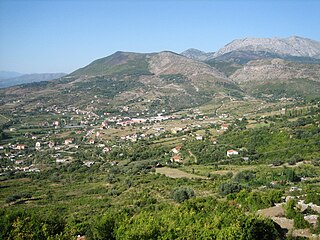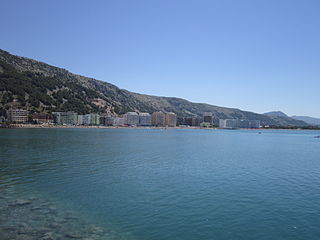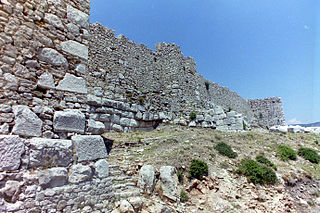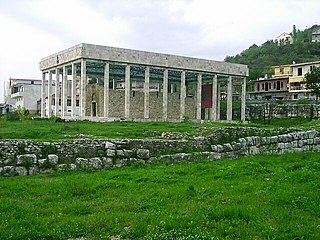Related Research Articles

Lezhë District was one of the 36 districts of Albania, which were dissolved in July 2000 and replaced by 12 newly created counties. It had a population of 68,218 in 2001, and an area of 479 km2 (185 sq mi). It is in the north-west of the country, and its capital was the city of Lezhë. The area of the former district is coextensive with the present municipality of Lezhë, which is part of Lezhë County.

Lezhë is a city in the Republic of Albania and seat of Lezhë County and Lezhë Municipality. It is one of Albania's continuously inhabited cities, with roughly 2,400 years of recorded history.

Lezhë County is one of the 12 counties of Albania. The population as of 2021 was 120,678, in an area of 1,620 km². Its capital is the city Lezhë.

The League of Lezhë, also commonly referred to as the Albanian League, was a military and diplomatic alliance of the Albanian aristocracy, created in the city of Lezhë on 2 March 1444. The League of Lezhë is considered the first unified independent Albanian country in the Medieval age, with Skanderbeg as leader of the regional Albanian chieftains and nobles united against the Ottoman Empire. Skanderbeg was proclaimed "Chief of the League of the Albanian People," while Skanderbeg always signed himself as "DominusAlbaniae".

The Parliament of Albania or Kuvendi is the unicameral representative body of the citizens of the Republic of Albania; it is Albania's legislature. The Parliament is composed of no less than 140 members elected to a four-year term on the basis of direct, universal, periodic and equal suffrage by secret ballot. The Parliament is presided over by the Speaker, who is assisted by at least one deputy speaker. The electoral system is based on party-list proportional representation. There are 12 multi-seat constituencies, corresponding to the country's counties.

Shëngjin is a coastal town and a former municipality in Lezhë County, northwestern Albania. At the 2015 local government reform it became a subdivision of the municipality of Lezhë. The population at the 2023 census was 6,963. Shëngjin is a growing tourist destination, well known for its beaches and resort accommodations. Shëngjin is one of many cities within the District of Lezhë and is home to one of Albania's entry ports, Port of Shëngjin.

Mamurras is a town and a former municipality in Lezhë County, northwestern Albania. At the 2015 local government reform it became a subdivision of the municipality Kurbin. The population at the 2023 census was 11,442.

Klubi i Futbollit Besëlidhja is an Albanian professional football club based in Lezhë. They are currently competing in Kategoria e Dytë, Group A. Their home ground is Brian Filipi Stadium.
Brian Filipi Stadium, a.k.a. former Besëlidhja Stadium is a multi-use stadium in Lezhë, Albania. It is currently used mostly for football matches and is the home ground of KS Besëlidhja Lezhë. The stadium holds 5,000 people.

The Diocese of Lezhë is a Latin Church diocese of the Catholic Church located in the city of Lezhë in the ecclesiastical province of Shkodër–Pult in Albania.

The Battle of Torvioll, also known as the Battle of Lower Dibra, was fought on 29 June 1444 on the Plain of Torvioll, in what is now Albania. Gjergj Kastrioti Skanderbeg was an Ottoman Albanian general who decided to return to his homeland and take the reins of a new Albanian league against the Ottoman Empire. He and 300 other Albanians who fought in the Battle of Niš deserted the Ottoman Army and made their way to Krujë, which quickly fell due to subversion. He then formed the League of Lezhë, a confederation of Albanian princes united in war against the Ottoman Empire. Realising the threat, Murad II sent one of his most experienced generals, Ali Pasha, to crush the new state with a force of 25,000 men.
Shënkoll is a village and a former municipality in the Lezhë County, northwestern Albania. At the 2015 local government reform it became a subdivision of the municipality Lezhë. The population at the 2023 census was 10,153.
Kolsh is a village and a former municipality in the Lezhë County, northwestern Albania. At the 2015 local government reform it became a subdivision of the municipality Lezhë. The population at the 2023 census was 3,817.

Kallmet is a former municipality in the Lezhë County, northwestern Albania. At the 2015 local government reform it became a subdivision of the municipality Lezhë. The population at the 2023 census was 2,973.

Blinisht is a village and a former municipality in the Lezhë County, northwestern Albania. At the 2015 local government reform it became a subdivision of the municipality Lezhë. The population at the 2023 census was 1,878.
Ungrej is a village and a former municipality in the Lezhë County, northwestern Albania. At the 2015 local government reform it became a subdivision of the municipality Lezhë. The population at the 2023 census was 465.

The Lezhë Castle is a castle dominating the city of Lezhë, northern Albania. Its highest point is 186 metres (610 ft). Lezhë Castle is at an elevation of 322 metres (1,056 ft). Lezhë Castle began as a Illyrian fortification. It was rebuilt by the Venetians in the 1440s and the Ottomans in 1522. In the late Middle Ages, the castle belonged to the Dukagjini family. The two brothers Tanush Dukagjini and Progon Dukagjini through an agreement which preserved their trade rights and estates around the castle placed the city and the castle under Venetian control in 1393 as a means to defend it against Ottoman expansion. The Venetians formally ceded the castle to the Ottomans in 1506.
Rraboshtë is a village located in the former Kallmet municipality, Lezhë County, northwestern Albania. At the 2015 local government reform it became part of the municipality Lezhë. The village is situated near the river Drin, about 4 km north of the city Lezhë. Nearby mountains include Mali Kastriot and Mali i Velës.
Balldren is a village and a former municipality in the Lezhë County, northwestern Albania. At the 2015 local government reform it became a subdivision of the municipality Lezhë. The population at the 2023 census was 3,792.

The Church of Saint Nicholas(Albanian: Kisha e Shën Nikollës/Kisha e Shna Kollit), former Selimije Mosque, or Church-Mosque of Lezhë (Kisha-Xhami) is a ruined historic church where the remains of Skanderbeg are said to be preserved in Lezhë, Albania. It is now used as Skanderbeg's Mausoleum.